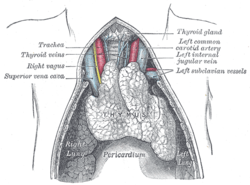Nezelof syndrome
Clinical
Features
Variants
Images
Differential
Histology
Features
Variants
Images
Differential
Pathophysiology
Epidemiology
Associations
Workup
Labs
Imaging
Diagnostic criteria
Management
Treatment
Monitoring
Counseling
Other considerations
| Nezelof syndrome | |
|---|---|
| Other names | Thymic dysplasia with normal immunoglobulins[1]: 85 |
 | |
| Autosomal recessive is the manner in which this condition is inherited | |
| Symptoms | Hepatosplenomegaly[2] |
| Causes | Currently unknown[3] |
| Diagnostic method | Blood test[3][4] |
| Treatment | Antimicrobial therapy, IV immunoglobulin[5] |
Nezelof syndrome is an autosomal recessive[6] congenital immunodeficiency condition due to underdevelopment of the thymus. The defect is a type of purine nucleoside phosphorylase deficiency with inactive phosphorylase, this results in an accumulation of deoxy-GTP which inhibits ribonucleotide reductase. Ribonucleotide reductase catalyzes the formation of deoxyribonucleotides from ribonucleotides, thus, DNA replication is inhibited.[medical citation needed]
Symptoms and signs
This condition causes severe infections. it is characterized by elevated immunoglobulins that function poorly.[7][8] Other symptoms are:[2]
Cause
Genetically speaking, Nezelof syndrome is autosomal recessive. the condition is thought to be a variation of severe combined immunodeficiency (SCID).[8] However, the precise cause of Nezelof syndrome remains uncertain[3]
Mechanism
In the mechanism of this condition, one first finds that the normal function of the thymus has it being important in T-cell development and release into the body's blood circulation[9] Hassal's corpuscles[10] absence in thymus(atrophy) has an effect on T-cells.[3]
Diagnosis
The diagnosis of Nezelof syndrome will indicate a deficiency of T-cells,[11] additionally in ascertaining the condition the following is done:[3][4]
- Blood test (B-cells will be normal)
- X-ray of thymus (atrophy present)
Differential diagnosis
The differential diagnosis for this condition consists of acquired immune deficiency syndrome and severe combined immunodeficiency syndrome[3][8]
Treatment
In terms of treatment for individuals with Nezelof syndrome, which was first characterized in 1964,[12] includes the following (effectiveness of bone marrow transplant is uncertain[4]) :
- Antimicrobial therapy[5]
- IV immunoglobulin[5]
- Bone marrow transplantation[5]
- Thymus transplantation[5]
- Thymus factors[5]
See also
References
- ↑ James, William D.; Berger, Timothy G.; et al. (2006). Andrews' Diseases of the Skin: clinical Dermatology. Saunders Elsevier. ISBN 978-0-7216-2921-6.
- ↑ 2.0 2.1 "Immune defect due to absence of thymus | Genetic and Rare Diseases Information Center (GARD) – an NCATS Program". rarediseases.info.nih.gov. Retrieved 2017-06-02.
- ↑ 3.0 3.1 3.2 3.3 3.4 3.5 Lavini, Corrado; Moran, Cesar A.; Uliano, Morandi; Schoenhuber, Rudolf (2009). Thymus Gland Pathology: Clinical, Diagnostic and Therapeutic Features. Springer Science & Business Media. p. 35 & 22. ISBN 9788847008281. Retrieved 7 June 2017.
- ↑ 4.0 4.1 4.2 Mosby (2016-04-28). Mosby's Dictionary of Medicine, Nursing & Health Professions - eBook. Elsevier Health Sciences. p. 1226. ISBN 9780323414197.
- ↑ 5.0 5.1 5.2 5.3 5.4 5.5 Smeltzer, Suzanne C. O'Connell; Bare, Brenda G.; Hinkle, Janice L.; Cheever, Kerry H. (2010). Brunner & Suddarth's Textbook of Medical-surgical Nursing (12 ed.). Lippincott Williams & Wilkins. p. 1563. ISBN 9780781785891. Retrieved 6 June 2017.
- ↑ Online Mendelian Inheritance in Man (OMIM): 242700
- ↑ Cantani, Arnaldo (2008-01-23). Pediatric Allergy, Asthma and Immunology. Springer Science & Business Media. p. 1298. ISBN 9783540333951.
- ↑ 8.0 8.1 8.2 Disorders, National Organization for Rare (2003). NORD Guide to Rare Disorders. Lippincott Williams & Wilkins. p. 408. ISBN 9780781730631.
- ↑ Pearse, Gail (2006-08-01). "Normal Structure, Function and Histology of the Thymus". Toxicologic Pathology. 34 (5): 504–514. doi:10.1080/01926230600865549. ISSN 0192-6233. PMID 17067941.
- ↑ Kierszenbaum, Abraham L.; Tres, Laura (2015-05-04). Histology and Cell Biology: An Introduction to Pathology E-Book. Elsevier Health Sciences. p. 339. ISBN 9780323313353.
- ↑ Wallach, Jacques Burton (2007). Interpretation of Diagnostic Tests. Lippincott Williams & Wilkins. p. 504. ISBN 9780781730556.
Nezelof syndrome diagnosis.
- ↑ Nezelof, C.; Jammet, M. L.; Lortholary, P.; Labrune, B.; Lamy, M. (October 1964). "Hereditary Thymic Hypoplasia: ITS Place and Responsibility in a Case of Lymphocytic, Normoplasmocytic and Normoglobulinemic Aplasia in an Infant". Archives Françaises de Pédiatrie. 21: 897–920. ISSN 0003-9764. PMID 14195287.
Further reading
- Lavini, Corrado; Moran, Cesar A.; Uliano, Morandi; Schoenhuber, Rudolf (2009-05-08). Thymus Gland Pathology: Clinical, Diagnostic and Therapeutic Features. Springer Science & Business Media. ISBN 9788847008281.
External links
- Dermatology
- Articles with short description
- Medical condition not in Wikidata
- All articles with unsourced statements
- Articles with unsourced statements from June 2017
- Articles with invalid date parameter in template
- Commons link is the pagename
- Immunodeficiency
- Noninfectious immunodeficiency-related cutaneous conditions
- Autosomal recessive disorders


